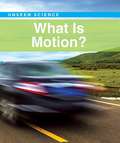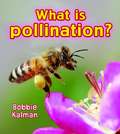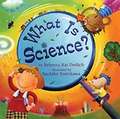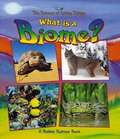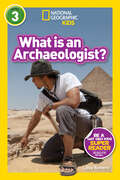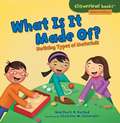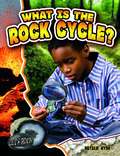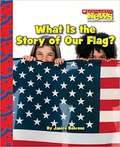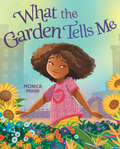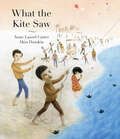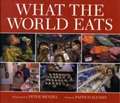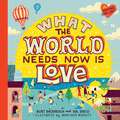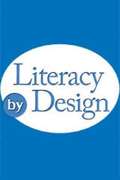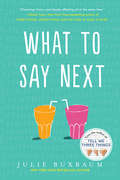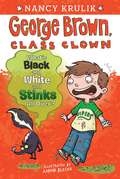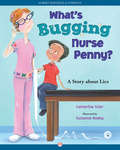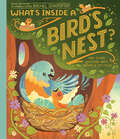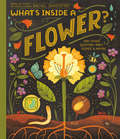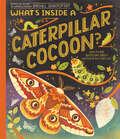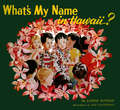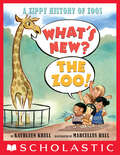- Table View
- List View
What is Motion? (Unseen Science)
by Laura L. SullivanWhat Is Motion? introduces readers to the science behind that question, explaining the physics behind the phenomenon through graphs and activities. Easy-to-understand summaries following each chapter highlights the most important points for review
What is Pollination? (Big Science Ideas #13)
by Bobbie KalmanPollination by insects is a critical function of all land ecosystems. Most orchard fruits, vegetables, and some field crops are pollinated by insects. This book features photographs that focus on the critical fact that protecting pollinators means having food to eat. It helps children look at insects in a different way. <P><P>Lexile Measure: 830
What is Science (Journeys 2014)
by Rebecca Kai DotlichA whirlwind tour through the intriguing world of science What exactly is science? Stars and planets, rocks and soil, hurricanes and airplanes-science is all of these things and so much more. It's also about curiosity: asking questions and exploring possible answers. Through simple words and child-friendly illustrations, this poetic picture book introduces young children to the exciting and ever-changing world of science. What Is Science? is a 2007 Bank Street - Best Children's Book of the Year.
What is a Biome? (The Science of Living Things)
by Bobbie KalmanIntroduces biomes, showing and describing the main kinds and discussing their location, climate, and plant and animal life, as well as those developed by humans. Lexile Measure: NC910L
What is an Archaeologist? (Readers)
by Libby RomeroIn this Level 3 reader, you can learn all about how archaeologists unearth history, from Egyptian pyramids to Incan roads, and everything in between.Travel around the world and back in time to learn about one of the coolest careers. Discover what archaeologists do, from digging through sand to traversing the jungle to diving into underwater caves. You'll explore exciting discoveries that change our perception of history and check out some of the newest technologies that let us dig deeper into the past than ever before. National Geographic Readers' combination of expert-vetted text, brilliant images, and a fun approach to reading has proved to be a winning formula with kids, parents, and educators. Level 3 text provides accessible yetwide-ranging information for fluent readers. Each reader includes text written by an experienced, skilled children's books author, a photo glossary, and interactive features in which kids get to reinforce what they've learned in the book.
What is it made of: Noticing Types of Materials
by Martha E. H. RustadListening and Exploration: Helping Clients Identify Their Experiences, Issues, and Problems; Clarification: Helping Clients Clarify Their Experiences and Develop Goals; Action: Helping Clients Take Action; Effective Communication: Facilitating Exploration, Clarification, and Action.
What is the Rock Cycle?
by Natalie HydeThis book talks all about the life cycle of rocks--their origin, types, and other interesting facts.
What the Garden Tells Me
by Monica MikaiThere&’s nothing like stepping into a garden and connecting with nature, and readers will revel in the pages of this beautiful picture book that celebrates these wondrous and inspiring places!Gardens are glorious places blossoming with joy, wonder, and wisdom too. Whether it&’s greeting the possibilities of each sunrise with the daylilies or appreciating what makes us as unique as the polkadot plant; whether it&’s contemplating life&’s thorns with the roses or standing as tall as a sunflower, spending time in nature can give us new ways of seeing. This flora-filled ode will inspire readers to observe the plants around them and appreciate the things that make each one—and each of us—special.
What the Kite Saw
by Anne Laurel CarterIn this memorable story, a young boy finds solace flying his kite from the rooftop after soldiers take his father and brother away. Without his father and brother, the young boy’s life is turned upside down. He and his family have to stay inside, along with everyone else in town. At suppertime, he can’t stop looking at the two empty places at the table and his sister can’t stop crying. The boy looks out the window and is chilled to see a tank’s spotlight searching the park where he plays with his friends. He hears shouts and gunshots and catches sight of someone running in the street — if only they could fly away, he thinks. Each day the curfew is lifted briefly, and the boy goes to the park to see his friends. One day, inspired by the wind in the trees, he has an idea. Back at home he makes a kite, and that night he flies it from his rooftop, imagining what it can see. In this moving story from Anne Laurel Carter, with haunting illustrations by Akin Duzakin, a young boy finds strength through his creativity and imagination. Correlates to the Common Core State Standards in English Language Arts: CCSS.ELA-LITERACY.RL.2.3 Describe how characters in a story respond to major events and challenges.
What the World Eats
by Faith D'Aluisio Peter Menzel<P>Sitting down to a daily family meal has long been a tradition for billions of people. But in every corner of the world this age-old custom is rapidly changing. From increased trade between countries to the expansion of global food corporations like Kraft and Nestle, current events are having a tremendous impact on our eating habits. Chances are your supermarket is stocking a variety of international foods, and American fast food chains like McDonald's and Kentucky Fried Chicken are popping up all over the planet. For the first time in history, more people are overfed than underfed. And while some people still have barely enough to eat, others overeat to the point of illness. <P> To find out how mealtime is changing in real homes, authors Peter Menzel and Faith D'Aluisio visited families around the world to observe and photograph what they eat during the course of one week. They joined parents while they shopped at mega grocery stores and outdoor markets, and participated in a feast where a single goat was shared among many families. They watched moms making dinner in kitchens and over cooking fires, and they sat down to eat with twenty-five families in twenty-one countries--if you're keeping track, that's about 525 meals! <P>The foods dished up ranged from hunted seal and spit-roasted guinea pig to U. N. -rationed grains and gallons of Coca-Cola. As Peter and Faith ate and talked with families, they learned firsthand about food consumption around the world and its corresponding causes and effects. The resulting family portraits offer a fascinating glimpse into the cultural similarities and differences served on dinner plates around the globe. <P>[This text is listed as an example that meets Common Core Standards in English language arts in grades 2-3 at http://www.corestandards.org.]
What the World Needs Now Is Love
by Burt Bacharach Hal DavidFor anyone who needs to be reminded of the power of love, this beautiful book is the perfect gift!With its soothing lyrics and calming tones, "What the World Needs Now Is Love" has become a beloved song worldwide since its release in 1965. Now, for the first time ever, these captivating lyrics are in book form accompanied by gorgeous illustrations, and perfectly packaged with a ribbon enclosure.Both a reminder of the importance of love and a call to make the world a better place, this book is the perfect gift for anyone you care about—or for yourself when you need some gentle comfort.
What to Say Next
by Julie Buxbaum<p>From the New York Times bestselling author of <i>Tell Me Three Things</i> comes a charming and poignant story about two struggling teenagers who find an unexpected connection just when they need it most. For fans of Sophie Kinsella, Jennifer Niven, and Rainbow Rowell. <p>Sometimes a new perspective is all that is needed to make sense of the world. <p>KIT: I don’t know why I decide not to sit with Annie and Violet at lunch. It feels like no one here gets what I’m going through. How could they? I don’t even understand. <p>DAVID: In the 622 days I’ve attended Mapleview High, Kit Lowell is the first person to sit at my lunch table. I mean, I’ve never once sat with someone until now. “So your dad is dead,” I say to Kit, because this is a fact I’ve recently learned about her. <p>When an unlikely friendship is sparked between relatively popular Kit Lowell and socially isolated David Drucker, everyone is surprised, most of all Kit and David. Kit appreciates David’s blunt honesty—in fact, she finds it bizarrely refreshing. David welcomes Kit’s attention and her inquisitive nature. When she asks for his help figuring out the how and why of her dad’s tragic car accident, David is all in. But neither of them can predict what they’ll find. Can their friendship survive the truth?
What's Alive? (Let's-Read-and-Find-Out Science 1)
by Kathleen Weidner ZoehfeldRead and find out about what makes something alive, and what all living things need to stay healthy, in this colorfully illustrated nonfiction picture book.A person and a cat have something in common: You are both alive. People and plants and animals are all alive, but is a doll alive? Or your bike? How can you tell?This is a clear and appealing science book for early elementary age kids, both at home and in the classroom. It's a Level 1 Let's-Read-and-Find-Out, which means the book explores introductory concepts perfect for children in the primary grades. The 100+ titles in this leading nonfiction series are:hands-on and visualacclaimed and trustedgreat for classroomsTop 10 reasons to love LRFOs:Entertain and educate at the same timeHave appealing, child-centered topicsDevelopmentally appropriate for emerging readersFocused; answering questions instead of using survey approachEmploy engaging picture book quality illustrationsUse simple charts and graphics to improve visual literacy skillsFeature hands-on activities to engage young scientistsMeet national science education standardsWritten/illustrated by award-winning authors/illustrators & vetted by an expert in the fieldOver 130 titles in print, meeting a wide range of kids' scientific interestsBooks in this series support the Common Core Learning Standards, Next Generation Science Standards, and the Science, Technology, Engineering, and Math (STEM) standards. Let's-Read-and-Find-Out is the winner of the American Association for the Advancement of Science/Subaru Science Books & Films Prize for Outstanding Science Series.
What's Black and White and Stinks All Over? #4
by Nancy Krulik Aaron BlechaGeorge Brown's super burps are causing serious trouble for poor George again. And this time the trouble really stinks! The super burp strikes on Field Day during an outdoor class scavenger hunt. George vows to keep out of any mischief, but he winds up getting skunked. .
What's Bugging Nurse Penny?
by Catherine Stier Suzanne BeakyNurse Penny is a fun and funky school nurse who wears honeybee earrings and a butterfly smock and carries a ladybug purse. But there's one kind of bug she'd rather not have around . . . head lice! So she calls a special school assembly to talk about those pesky critters--what they look like, how to avoid them, and how to get rid of them. After all, lice can happen to anyone--even the school nurse!
What's Claude Doing?
by Dick GackenbachA dog refuses all the neighborhood pets' invitations to come out to play, not admitting that he's generously keeping his sick master company.
What's Faster Than A Speeding Cheetah?
by Robert E. WellsWhat's faster than a cheetah?--no animal on earth can run faster. But a peregrine falcon can swoop faster than a cheetah can run. And the falcon can't compare to an airplane, a rocket, or the speed of light.
What's Faster Than a Speeding Cheetah?
by Robert E WellsWhat's faster than a cheetah?--no animal on earth can run faster. But a peregrine falcon can swoop faster than a cheetah can run. And the falcon can't compare to an airplane, a rocket, or the speed of light. Lively text and watercolors will make children laugh while they learn all about speed.
What's Inside A Bird's Nest?: And Other Questions About Nature & Life Cycles (What's Inside)
by Rachel IgnotofskyDiscover the next nonfiction picture book about eggs, nests, and birds from the creator of the New York Times bestseller Women in Science, Rachel Ignotofsky! Want to learn more about the bird that chirps outside your window? Ignotofsky crafts a perfect read out loud with a touch of humor and compassion for our friends with wings in the sky!Find out more from the moment they hatch, to how they create their homes in this perfectly detailed and soon-to-be springtime favorite read!Rachel Ignotofsky's beautiful, distinctive art style and engaging, informative text clearly answers any questions a child (or adult) could have about birds, eggs, and nests in this nonfiction picture book series.
What's Inside A Flower?: And Other Questions About Science & Nature (What's Inside)
by Rachel IgnotofskyFrom the creator of the New York Times bestseller Women in Science, comes a new nonfiction picture book series ready to grow young scientists by nurturing their curiosity about the natural world--starting with what's inside a flower.Budding backyard scientists can start exploring their world with this stunning introduction to these flowery show-stoppers--from seeds to roots to blooms. Learning how flowers grow gives kids beautiful building blocks of science and inquiry.In the launch of a new nonfiction picture book series, Rachel Ignotofsky's distinctive art style and engaging, informative text clearly answers any questions a child (or adult) could have about flowers.
What's Inside a Caterpillar Cocoon?: And Other Questions About Moths & Butterflies (What's Inside)
by Rachel IgnotofskyWith warm and heart-fluttering illustrations, discover the next nonfiction picture book about butterflies and moths from the creator of the New York Times bestseller Women in Science!Butterflies soar in the sunlight. While moths flutter under the moon and stars.Find out more about these mysterious and majestic insects similarities and differences, and their awestrucking metamorphosis! Rachel Ignotofsky's distinctive art style and engaging, informative text clearly answers any questions a child (or adult) could have about butterflies and moths in this nonfiction picture book series.
What's My Name in Hawaii?
by Ray Lanterman Louise BonnerWhat's My Name in Hawaii? is a multicultural children's story of a little Japanese boy's search for a name.He needs a new one because he is about to become an American citizen in Hawaii, where his parents have come to live from faraway Japan.<P><P>When Toshio Takahashi first goes to school he does not want to play with the other children. Like most beginners, he cries because he misses his mother and mostly because he does not speak or understand English. Language, however, proves no barrier in a child's world and soon Toshio is just another flower in the school called Na Lei o Ka Keiki, "a lei of children".When Toshio's citizenship day approaches, all of his young schoolmates wish to help him select an American name like theirs, to add to those reflecting their various racial backgrounds. Susan Iwalani Au suggests "John" and Lisa Ilima Santiago offers "Gaylord" because she has an uncle by that name.The final choice is a happy one for all most of all, to Toshio whose new name now reveals that he was born in Japan, but is an American citizen living in Hawaii, the 50th State of America.
What's New? The Zoo!: A Zippy History of Zoos
by Kathleen KrullWith friendly facts, funny pictures, and animals galore, What's New? The Zoo! is history to roar for!Did you know . . . * The first zoo was established forty-three hundred years ago in what is now Iraq?* Aztec King Moctezuma II had such an incredible collection of animals that it took six hundred men and women to care for them?* Children across Great Britain wrote to Queen Victoria when Jumbo the elephant was sold away from the London Zoo?* Fifty buffalo passed through Grand Central Station in 1907 on their way to the Bronx Zoo?* Zoos now play a crucial role in animal conservation?Kathleen Krull and Marcellus Hall bring witty insight, jazzy style, and a globe-trotting eye to our millennia-long history of keeping animals -- and the ways animals have changed us in turn.
